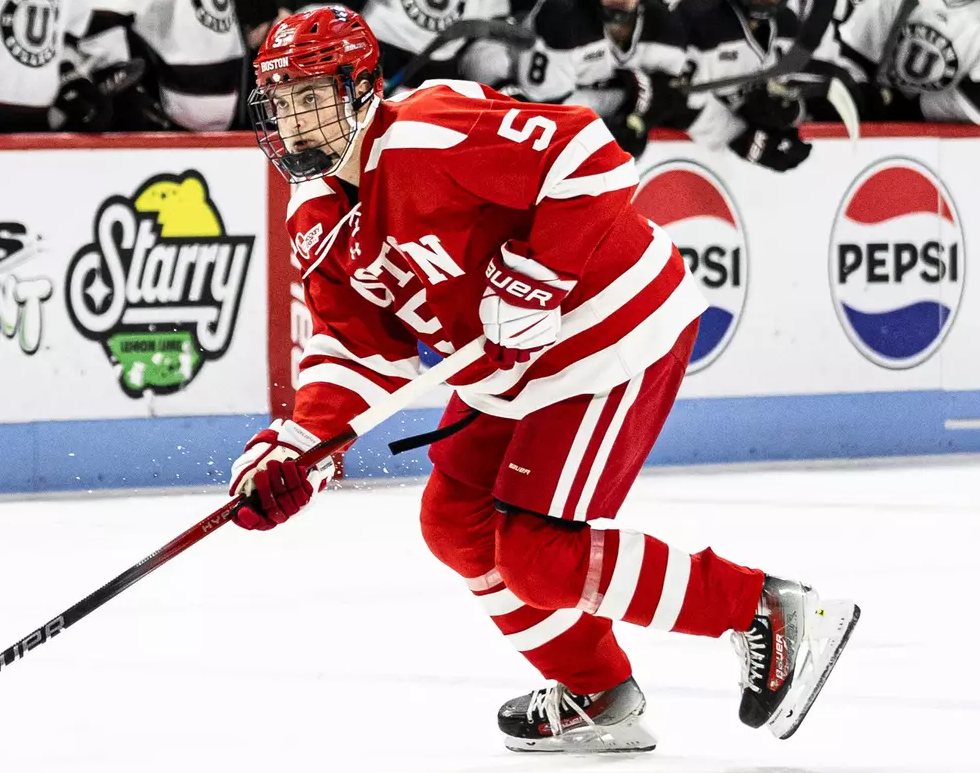NHL News
When Entry Level Negotiations go from Swede to Sour

Special for PuckPedia by Steve Werier, former Florida Panthers Assistant General Manager.
Photo by Matt Woolverton, courtesy of Boston University Athletics
In 1998, two young engineers in California had the idea to start a company that could help people find things online. They started meeting with potential investors and were turned down by the first few because they didn’t have a real business plan yet. One day, they met at a coffee shop with an investor who recognized they were sharp guys he wanted to bet on. So the investor went back to his car and cut them a check for $100,000. The founders asked him “wait, what percentage of the company do we have to give you for your $100K?” (a key issue in startup investing). The investor replied – basically – “whatever, you guys figure that out and get back to me” and drove off. Anyway, it all worked out. The founders were named Larry and Sergei and they called their new company “Google”. The investor made lots of money. I forget how much, but there’s places you can look that up.
The point of the story is that sometimes it makes sense to focus your efforts on making sure you lock down relationships with people you believe are going places, and not get bogged down in details that could derail the relationship before it really begins.
Which brings us to Tom Willander, the Vancouver Canucks, and entry level contract negotiations under the NHL’s CBA.
Reading Between the Lines in Vancouver
If you watched Jim Rutherford and Patrik Allvin’s year-end press conference on Monday, there were highlights. Rutherford sort of conceded that franchise defenseman Quinn Hughes may want to play with his brothers when he becomes a free agent and wondered if maybe he could solve the problem by enticing Jack and Luke Hughes to leave the New Jersey Devils for the Canucks. It probably won’t happen, but I thought it was a funny idea. Next bit, Jim.
What I found more interesting was Allvin saying the Canucks believe their 2023 first-rounder Tom Willander (drafted 11th overall) is planning to return to college next season and will not be signing with the Canucks.
What’s the Hold-Up?
The Canucks and Willander’s camp have been engaged in seemingly contentious negotiations over the last couple weeks, at least for what is typically a pretty lowkey process. Last week, Frank Seravalli reported there was an agreement in place, only for Willander’s advisor to refute the report as being “totally false”. Since then, Vancouver media have reported that “talks are going nowhere and there is no communication between the club and player” and that the impasse is related to “Schedule A bonuses”.
I’ve negotiated several entry level contracts, including some for high-drafted, highly regarded defenseman like Willander who went to college before signing their pro deals. And while some of those negotiations became protracted, those typically involved players who our management group wasn’t particularly high on at the time of the negotiations (in other words, we were intentionally making below market offers relative to where the player was drafted). But in cases where we were still optimistic about the player’s potential, we were typically able to close the negotiations rather quickly.
Inside the ELC Contracts
Here’s how it usually works:
Under the CBA, an entry level player can sign a contract containing four main components: (1) NHL base salary, (2) NHL signing bonus, (3) NHL performance bonuses and (4) AHL base salary. The number of contract years is based on the player’s age on September 15 of the calendar year in which he signs. Willander is 20 so he’s only eligible for a 3-year ELC.
NHL salary is determined based on the player’s draft year -- for players drafted in 2023 like Willander, it’s capped at $950K. Anyone drafted in the first couple rounds is going to sign for that amount and will receive a signing bonus of $95K (signing bonuses are capped at 10% of the base salary). There’s nothing to negotiate here.
The performance bonuses are where the action is. ELC players are eligible for “A” and “B” bonuses. “A” bonuses are currently capped at $250K individually and $1 million in the aggregate. They are achievable based on certain positional milestones; for a defenseman like Willander, they include 10 goals, 25 assists, 40 points as well as ice time, plus-minus, and blocked shot total, in addition to receiving certain honours like All Star MVP. A player can only achieve a maximum of 4 A Bonuses in an ELC season.
"A" Bonuses are typically given to players drafted in the first round like Willander. The aggregate amount of A Bonus eligibility is negotiated on a sliding scale that is primarily based primarily on the player’s draft position but also can consider exceptional post-draft performance (see Zeev Buium’s bonus structure in the table below).
Any bonuses more than the $1M cap are deemed to be “B” bonuses, which are tied to league-wide positional rankings and awards. You can read about those here but they are typically only offered to top 10 draft picks, so they aren’t relevant to our analysis.
There are good reasons why teams want to limit their ELC bonus exposure.
If a player achieves any A or B bonuses, those amounts count against the club’s salary cap the following season if they do not finish the current season with sufficient cap space to absorb the bonus charge. 11 teams in 25-26 have a bonus overage cap charge from 24-25. So, if a club thinks they’ll be a cap team in the future they’ll want to minimize their potential overage risk. We experienced an overage one year in Florida when Aaron Ekblad achieved multiple A bonuses and a B bonus worth millions of dollars each, and we had to navigate around it the ensuing offseason.
How Much Are We Really Talking About?
Having said that, when it comes to Willander, we aren’t talking about a battle over millions of dollars in bonuses. Without being privy to the negotiations, we can be quite sure the gap between the club and player is at most $200,000.
We know the gap is small for two reasons: (1) because the A Bonus max is $1MM and (2) because the cohort plausibly comparable players based on draft position and post-draft performance have almost all received upwards of $750K in A Bonuses.
You can compare Entry Level Deals of players by looking at the draft results page for that year.
| Player | Draft Year/Club | Draft Position | A Bonus Average | College (Y/N) |
| Pavel Mintyukov | 2022 ANA | 10 | 783K | N |
| Conor Geekie | 2022 AZ | 11 | 767K | N |
| Denton Mateychuk | 2022 CBJ | 12 | 750K | N |
| Frank Nazar | 2022 CHI | 13 | 900K | Y |
| Dalibor Dvorsky | 2023 STL | 10 | 783K | N |
| TOM WILLANDER | 2023 VAN | 11 | ? | Y |
| Daniel But | 2023 AZ | 12 | ? | N |
| Zach Benson | 2023 BUF | 13 | 650K | N |
| Zeev Buium | 2024 MIN | 12 | 1M | Y |
We’ve noted who, like Willander, went the college route after being drafted because those players are given additional leverage under the CBA: the option to spend 4 years in college and then sign with a team of their choice as a UFA (CHL players, by contrast, do not earn this right).
Another factor to consider is the rising salary cap, which will have risen from $83.5M in 2023-24 to upwards of $113M in 2027 (the last year of Willander’s ELC, should he sign this summer).
Finally, a player’s performance following his draft year is also a relevant factor, and the reason why Buium received max A bonuses. The consensus among scouts and staff around the league is that Willander’s college and international play has solidified his status as an “A” prospect.
Taken together, it seems reasonable to set the floor for Willander’s A bonuses in the range of $775K, with the ceiling somewhere in the high 8’s.
Of course, one risk for the Canucks here is that the market could reset and other players drafted in a similar position to Willander could sign for a higher-than-expected amount of “A” bonuses. The market could of course move downwards as well, but I think that’s less likely amid a rising cap. Notably, Daniel But (who was drafted immediately after Willander at #12 in 2023) shares the same adviser as Willander and has yet to sign his own ELC. As Elliotte likes to say, we’ll see where this goes.
Time to Play the Long Game
A front office in the cap world must practice some frugality. But if Willander does go back to school and gets closer to the “do I stay one more year and become a UFA” crossroads, then the risk/reward calculus could shift. If they truly think Willander is a player capable of earning those A bonuses in the NHL, they may want to add what amounts to a rounding error to their future cap commitments to make sure he earns those bonuses as a Canuck. The Canucks and Willander are at the startup stage of their relationship. If the teams wants to lock in a long-term relationship, they should realize that the gap in “A” bonuses is juice that isn’t worth the squeeze. There will hopefully be a time and place for hardball negotiating over larger amounts. But that time is not now.
Steve Werier joined the Florida Panthers in 2014 and was Assistant General Manager from 2016 to 2017. He's currently the general counsel to a New York based tech venture company.








